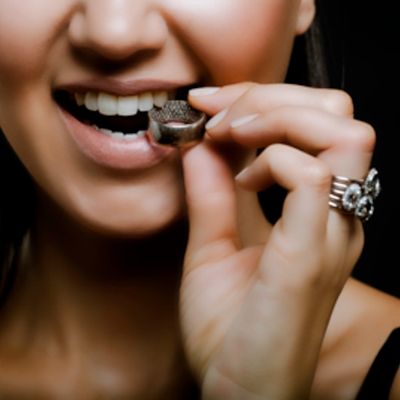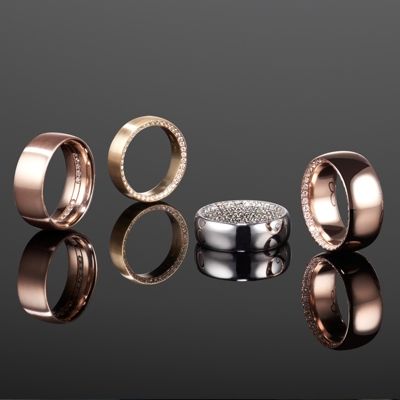Precious Metals: Tips from an Expert to Become an Expert
What makes a metal precious? Technically speaking, “precious metals” are a group of rare and valuable metals used in industry, technology, decoration, or coinage. They are less reactive (i.e. more resistant to rust and tarnishing) than other metals. What makes these metals precious are what make all things precious: they are rare, valuable and should be utilized thoughtfully. We gift them to the most precious people in our lives and use them as symbols of ceaseless devotion. Before you decide on platinum, palladium, yellow, rose, or gray gold for your next fine jewelry masterpiece, read on for a primer.
Yellow Gold
Pure 24 karat gold was used in fine jewelry dating as far back as 4000 B.C.! Today one can see examples of these luxurious works in museums across the world. Loved for its rich hue, 24 karat is beautiful but not commonly used today for fine jewelry. It is malleable, scratches and dents easily with everyday wear which some fine off-putting while others enjoy the patina that ensues with wear.
David Alan uses 18 karat yellow gold for some of our fine jewelry. Eighteen karat yellow gold is 75 percent pure gold, combined with 25 percent other alloys such as copper, silver, zinc, and on occasion, nickel. David Alan’s 18 karat yellow gold does not contain nickel since this can be an allergen for some people.
Using 18 karat yellow gold is the perfect way to achieve a rich sultry gold hue with the promise of longevity as the alloys help to provide everyday wearability. Even with regular use, your 18 karat yellow gold David Alan heirloom will last for generations to come.
Rose Gold
Rose gold, loved for its pink color, was first used in early 19th century Russia by the famed jeweler Carl Fabergé in his Fabergé Eggs. It was known as Russian Gold. Eighteen karat rose gold is used for some of our David Alan fine jewelry today. Eighteen karat rose gold is 75 percent pure gold, combined with 25 percent alloys, usually copper and silver. It is the traces of copper which provide an unmistakable pink glow. Even with regular wear, your David Alan rose gold heirloom will last for generations to come.
Some of the hottest Hollywood starlets are choosing 18 karat rose gold engagements rings including celebrities Hailey Beiber, Blake Lively and Emma Roberts. This has helped fuel the obsession with this precious metal, making its use one of the hottest trends in engagement rings today.
Gray Gold
The lesser known 18 gray gold is an alloy of gold and palladium. While palladium doesn’t have the name recognition of gold or platinum, it is just as valuable. David uses 18 karat gray gold for many of our men’s wedding bands. It has a chic and subtle silvery finish making it a sultrier alternative to the stark white elegance of platinum. Note that gray gold is oftentimes confused with white gold however, they are not the same, as we will discuss below.
Palladium
Palladium is a luminous, silvery-white precious metal. It is considered a noble metal, chemical element, and sister to platinum. A rare precious metal, palladium has been commonly used for fine jewelry since the 1930s, gaining popularity again recently.
In 2019, Fortune reported that palladium was now more valuable than gold. Contrary to a myth, palladium is not white gold. It is noncomedogenic, unlike white gold, which can cause irritation to those with sensitive skin. It never changes color like white gold. Like silver, it is also pure white yet much more durable. It’s suitable and comfortable for everyday wear.
Read more about what David Alan say about Palladium in this article with Brides.com!
Platinum
Platinum is David Alan’s premier choice in precious metals for three reasons:
- Cool toned color: This precious metal will not change color as it is naturally white.
- Purity: Platinum is 95% pure (hence the marking PT950). Platinum is denser than gold to begin with, and less alloyed. You can feel the (weight) difference in your hand.
- Wearability: It’s hypoallergenic, rarer, and harder, making it more durable than gold.
To learn more about platinum from the source itself check out resources on Platinum Guild International’s (PGI) website here! Platinum Guild International (PGI) is your resource for all things platinum jewelry – from platinum information to wedding jewelry buying tips.
What about White Gold and Silver?
White gold is confused with other white metals even though it is not actually “white.”
Keen insider tip! White gold has a slight yellow hue and only appears white once it is plated with rhodium. What is rhodium? Rhodium is a very rare chemical element that is silvery-white, hard, and corrosion-resistant. Unfortunately, it is not permanent and will rub off with regular wear.
David’s training with the finest jewelers in the Old-World techniques has helped to form his high standards, which are now ingrained into his work and brand ethos. Therefore, David Alan takes a unique stance against using white gold. The David Alan brand makes masterpiece heirlooms that last for generations, maintaining their beauty and integrity for decades to come.
As for silver, it is also considered a precious metal. While sterling silver is structurally durable, it is prone to tarnishing because it is alloyed with 25% copper. Further, sterling silver is too soft to secure valuable gemstones for a lifetime of wear.
If you want pristine fine jewelry in “white” metal, David Alan offers three superior options: Platinum, 18 karat gray gold and palladium.
What Is Precious to You?
At David Alan, we don’t believe in laying down rules about skin tone and precious metal color. You get to choose what is most precious to you for your treasured forever, fine jewelry. Book a complimentary 15-minute consultation to collaborate with us today.


